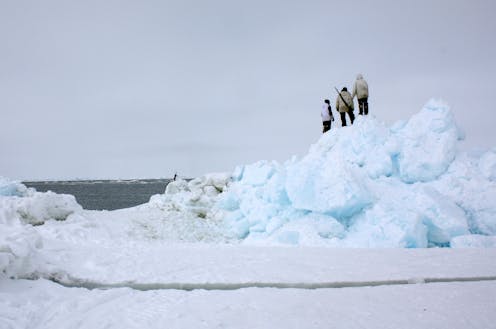2021 Arctic Report Card reveals a (human) story of cascading disruptions, extreme events and global connections
- Written by Matthew Druckenmiller, Research Scientist, National Snow and Ice Data Center (NSIDC), Cooperative Institute for Research in Environmental Sciences (CIRES), University of Colorado Boulder

The Arctic has long been portrayed as a distant end-of-the-Earth place, disconnected from everyday common experience. But as the planet rapidly warms, what happens in this icy region, where temperatures are rising twice as fast as the rest of the globe[1], increasingly affects lives around the world[2].
On Dec. 14, 2021, a team of 111 scientists from 12 countries released the 16th annual Arctic Report Card[3], a yearly update on the state of the Arctic system. We are[4] Arctic[5] scientists[6] and the editors of this peer-reviewed assessment. In the report, we take a diverse look across the region’s interconnected physical, ecological and human components.
Like an annual checkup with a physician, the report assesses the Arctic’s vital signs – including surface air temperatures[7], sea surface temperatures[8], sea ice[9], snow cover[10], the Greenland ice sheet[11], greening of the tundra[12], and photosynthesis rates by ocean algae[13] – while inquiring into other indicators of health and emerging factors that shed light on the trajectory of Arctic changes.
As the report describes, rapid and pronounced human-caused warming continues to drive most of the changes, and ultimately is paving the way for disruptions that affect ecosystems and communities far and wide.
A closer look at the 2021 Arctic Report Card.Continued loss of ice
Arctic Sea ice – a central vital sign and one of the most iconic indicators of global climate change – is continuing to shrink[14] under warming temperatures.
Including data from 2021, 15 of the lowest summer sea ice extents – the point when the ice is at its minimum reach for the year – have all occurred in the last 15 years[15], within a record dating back to 1979 when satellites began regularly monitoring the region.
The sea ice is also thinning at an alarming rate as the Arctic’s oldest and thickest multi-year ice disappears. This loss of sea ice diminishes the Arctic’s ability to cool the global climate. It can also alter lower latitude weather systems[16] to an extent that makes previously rare and impactful weather events, like droughts, heat waves and extreme winter storms, more likely.
Similarly, the persistent melting of the Greenland ice sheet[17] and other land-based ice is raising seas worldwide, exacerbating the severity and exposure to coastal flooding, disruptions to drinking and waste water systems, and coastal erosion for more communities around the planet.

















